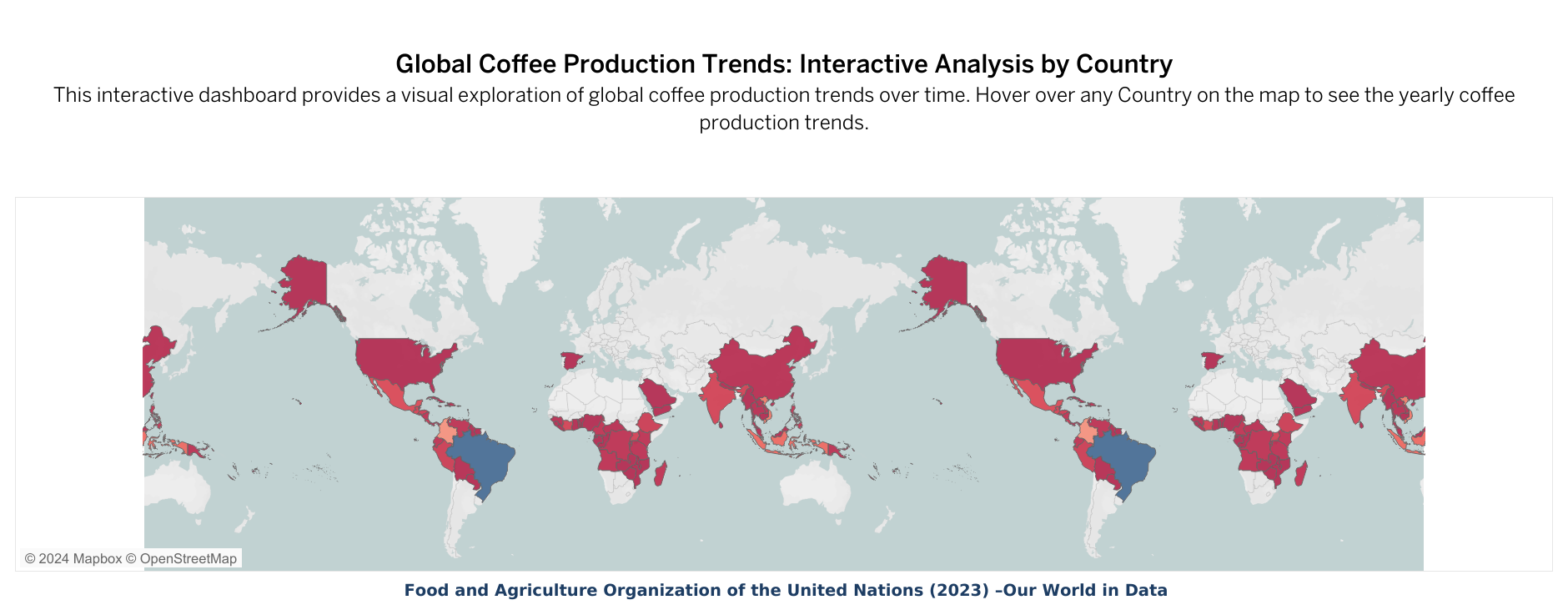Coffee Lover : Deep Dive into Global Production Trends (1990–2020)
As someone coffee lover who can’t start the day without a strong cup of coffee, I’ve often found myself wondering about the origins of this beloved beverage. Where do those aromatic beans that fill my kitchen with such a heavenly scent every morning come from? What parts of the world contribute to the caffeine-fueled magic that helps me—and millions of others—get through the day? My curiosity led me to dive deep into the world of coffee production, and what I discovered was nothing short of fascinating.
The journey began with a simple idea: to analyze global coffee production trends. Using data from the Food and Agriculture Organization of the United Nations, I set out to visualize where coffee is grown around the world, and how production has evolved over the years. Armed with Tableau and a treasure trove of data, I was ready to embark on this caffeinated adventure.

A World of Coffee
As the map reveals, coffee is grown in some of the most diverse regions of the world. From the lush rainforests of South America to the highlands of Ethiopia, and the tropical landscapes of Southeast Asia, coffee production is as varied as the flavors and aromas of the beans themselves.

This chart clearly illustrates Brazil’s dominance in coffee production, with a steady increase over the decades. What’s particularly interesting is the rapid rise of Vietnam, which has surged to become the second-largest coffee producer in the world. This growth reflects Vietnam’s successful expansion of coffee farming, particularly in Robusta beans, which are often used in instant coffee.
Indonesia and Colombia also show significant contributions, though their production levels remain relatively stable compared to the rapid growth seen in Vietnam. Other countries, like Guinea, show smaller but still notable contributions to the global coffee supply.

South America: The Coffee Powerhouse
No conversation about coffee production would be complete without mentioning South America, and in particular, Brazil. Brazil is the world’s largest producer of coffee, and it’s no surprise that it dominates the map. With vast plantations stretching across its landscape, Brazil produces a variety of coffee beans that are enjoyed worldwide. Colombia, another coffee giant, is known for its high-quality Arabica beans, which are often used in premium blends. These countries, along with others like Peru and Ecuador, make South America a true coffee powerhouse.
Africa: The Birthplace of Coffee
Africa holds a special place in the history of coffee, with Ethiopia being widely regarded as the birthplace of the coffee bean. Ethiopian coffee is known for its rich, complex flavors, often with fruity or floral notes. In addition to Ethiopia, countries like Uganda and Ivory Coast are significant players in the coffee market. African coffee is prized for its unique characteristics, shaped by the continent’s diverse climates and soils.
Asia: The Growing Coffee Continent
Asia is an emerging force in the coffee world, with countries like Vietnam and Indonesia leading the charge. Vietnam, in particular, has become the world’s second-largest coffee producer, thanks to its robusta beans, which are known for their strong, bitter flavor and high caffeine content. Indonesia’s coffee, often grown on the islands of Sumatra and Java, is known for its earthy, full-bodied profile. The map also highlights India, where coffee production has been steadily increasing, with a focus on both Arabica and Robusta beans.
The Trends and What They Mean
The charts and dashboard not only highlights where coffee is grown but also hints at how production is changing over time. For instance, the rise of Asian countries in the coffee production world reflects shifting economic and agricultural trends, with nations like Vietnam rapidly scaling up production to meet global demand.
On the other hand, the consistency of coffee production in traditional coffee powerhouses like Brazil and Colombia shows the enduring importance of these regions in the global coffee market. However, with climate change impacting growing conditions, it will be interesting to see how these trends evolve in the future.
A Personal Reflection
Analysing and creating charts and dashboard was more than just a data analysis project; it was a way to connect with the global community of coffee lovers. Every time I sip my morning coffee, I now think about the complex journey those beans have taken—from the farms of Brazil or Ethiopia, through the roasting process, to finally arriving in my cup. It’s a journey that spans continents, cultures, and countless hands, all working together to create the beverage we all love.
This exploration has deepened my appreciation for coffee, not just as a drink, but as a global product that connects us all. So next time you enjoy your coffee, take a moment to think about where it came from, and the world of effort behind that perfect cup.
If you’re as passionate about coffee as I am, or if you’re just curious about the origins of your daily brew, I invite you to explore this interactive dashboard and dive into the world of global coffee production. You might just discover a new appreciation for that morning ritual we all cherish.


